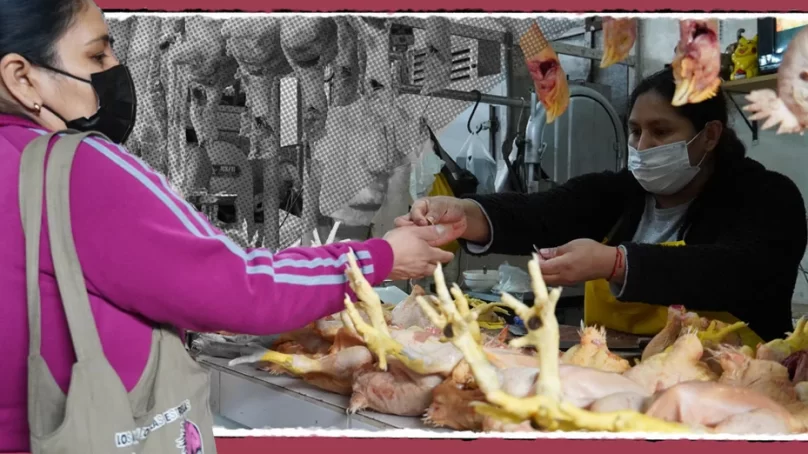
Rising prices, government mismanagement, dietary habits and an over-reliance on imported food staples and fertiliser have left half of Peruvians struggling to feed themselves, the Food and Agriculture Organization has warned.
A recent report by the UN agency put the Andean country in top position in South America in terms of food insecurity, at levels never seen before.
Peru has been left reeling from the Covid-19 pandemic. It suffered the world’s highest mortality rate – more than 0.65 per cent of its population has died from the virus, while lockdowns drove up unemployment. The poverty rate in 2021 stood at 25.9 per cent. Pre-pandemic, it was 20 per cent, according to Peru’s national statistics institute.
Now, the Andean nation – classed by the World Bank as an upper middle-income country – is facing the double shock of a post-pandemic downturn and imported inflation, driven by the war in Ukraine. Staples like wheat, rice, and cooking oil have more than doubled in price, while imported chemical fertilisers cost up to four times what they did a year ago.
As a result, a growing number of Peruvians are resorting to soup kitchens, known as ollas comunes. In June 2022, the Ministry of Development and Social Inclusion passed a decree recognising them as social organisations and guaranteeing their financing, underlining the critical role they now play in feeding the population.
The number of soup kitchens registered with Lima’s municipal government has risen sixfold in the last two years – from 377 at the outset of the pandemic in July 2020 to more than 2,500 today.
While some received local government assistance, many began with no support, like La Granja in Alto Retamal – a dusty, fog-shrouded hillside in Villa María del Triunfo, one of the capital’s main shantytowns.
“This began due to the economic factor in the pandemic,” recalled Pablo Condori, 69, its organiser. “Everything was shut. There were no shops. So, we collected food between ourselves.
“It was only supposed to be for a while, but [the pandemic ended and] we realised that we still needed it,” he said.
The sea fog had not lifted by lunchtime on an August afternoon when locals arrived at the wooden shack for a hot dish of stewed wheat and rice served with salad and a drink made from fresh apples.
Price hikes of food and cooking gas have tripled the cost of a meal. At the start of the pandemic, it was just one Peruvian sol ($0.26). Now, it’s three soles ($0.78). Meat or fish are only served a couple of times a week, said Jessyca Laguna, 67, another La Granja organiser.
“Everything is so much more expensive,” said Laguna, stirring a pot of steaming rice. “A sack of rice that used to cost $20 to $25 now costs $43 to $45 depending on the brand and quality. Potato prices have gone up too,” she added.
The kitchen workers, including Laguna, are all women in their 60s, unable to find other work and looking to help neighbours with health problems – among them a former builder who suffered a stroke.
“There are many health and financial needs here, so we carry on with this soup kitchen,” said Laguna.
Peru is where the potato was first cultivated, after being domesticated some 7,000 years ago on the shores of Lake Titicaca. The country’s rich biodiversity and culture have given it world-renowned gastronomy and turned its coastal capital, Lima, into a fine dining hub.
It faces huge challenges now. While it’s a top exporter of cranberries, peppers, grapes and asparagus, it’s also a net importer of wheat, soy, fertiliser and energy, making it particularly vulnerable to global inflation and the economic fallout of the Russian invasion of Ukraine.
In August, the annual inflation rate in Peru stood at 8.41 per cent, on a par with the soaring regional average. The FAO says more than half of Peru’s 33.4 million population are now food insecure – meaning “they lack regular access to enough safe and nutritious food for normal growth and development and an active and healthy life”. This compares to less than a quarter before the pandemic.
The UN agency also warned of rising malnutrition and other issues such as anaemia and obesity, as more than half of the country can’t afford a healthy diet, which on average costs $3.28 per person per day – beyond the reach of many households.
“We have all the elements for a perfect storm,” Enrique Román, FAO’s assistant representative in Peru, told The New Humanitarian, listing climate change and the economic shocks caused by the pandemic and the Russian invasion of Ukraine as the main drivers.
Román said Peru also had two particular vulnerabilities: extremely high informal employment – more than 70 percent of the workforce have no job stability or social security; and high transport costs across the Andes and the Amazon rainforest to bring produce to market.
Despite being a food producer, Peru is also overly reliant on imported staples, Román explained. For example, chickens – the main source of protein for Peruvians – are mostly fed with imported yellow maize.
As a result, the price of chicken has doubled. At the market in Mala, an agricultural town about 80 kilometres south of Lima, Lucia Rivas, 36, said trade is even worse now than during the pandemic and she is struggling to support her two children. She used to do a roaring trade in chickens, earning about 25 cents a kilo. Now, she barely makes a profit of $10 a day.
“Before, I sold between 40 or 50 chickens a day, up to 60, and now I’m selling between 20 and 30. You can do the maths!”, she said.
- The New Humanitarian report











